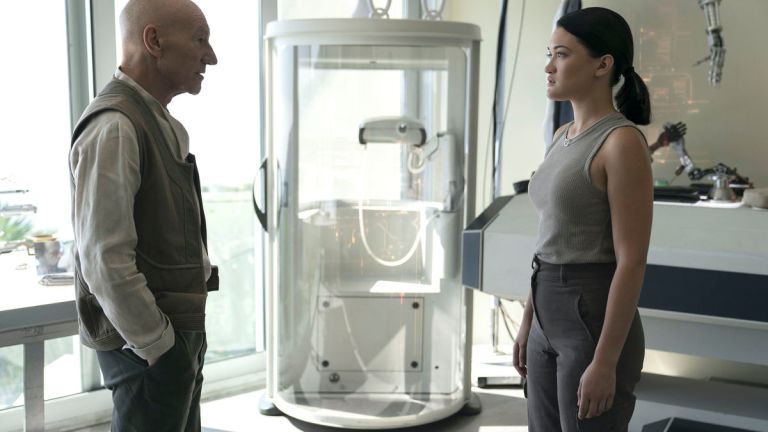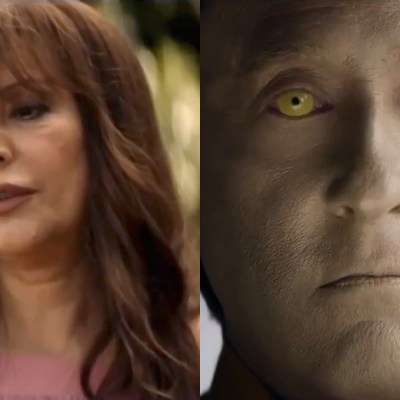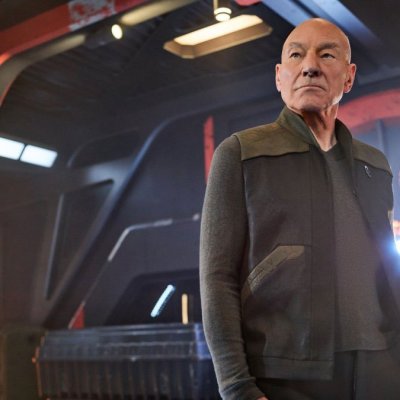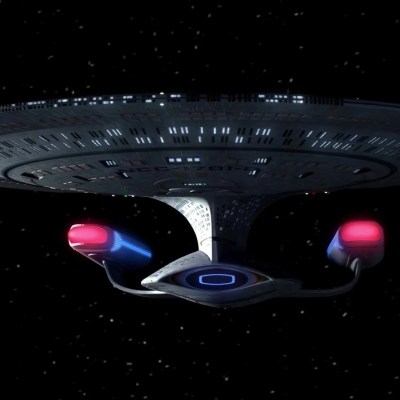Star Trek: Picard Episode 9 Easter Eggs and References
Did you catch all of the Star Trek references and Easter eggs in the Star Trek: Picard episode "Et in Arcadia Ego, Part 1"?

This article contains major Star Trek: Picard episode 9 spoilers.
As the ambitious — and compact — first season of a Star Trek: Picard comes screaming down the transwarp conduit, the epic two-part finale is revisiting countless references to the entire history of the franchise. Because each episode of Picard is so densely written, and packed with nuance, it’s hard for Trekkie geek detectives to notice every, single tiny Easter egg and reference. But, in the name of Q, we’ll try!
From a famous form of Klingon martial arts, to several sideways references classic ‘60s Trek episodes, and more than one huge callback to Star Trek: The Next Generation, here are all the Easter eggs and references we caught in the lead-up to the big Star Trek: Picard season finale, “Et in Arcadia Ego Part 1.”
“Et in Arcadia Ego”
The title of this episode is not the first Star Trek episode to sport a Latin phrase. In Deep Space Nine, the episode “Inter Arma Enim Silent Lēgēs” roughly translates to “In time of war the law falls silent.” In Discovery, the episode “Si Vis Pacem Para Bellum,” is Latin for, “If you want peace, prepare for war.” But the literal translation of “Et in Arcadia Ego” isn’t what makes this title so interesting.
“Et in Arcadia Ego” translates to “And in Arcadia, I am.” But what does that mean? Well, this title actually refers to a Nicolas Poussin painting of the same name, which depicts shepherds chilling near a tomb. Scholars, philosophers, and other smart folks generally consider the painting — and the associated phrase — to be a critique or a study of, the nature of a utopia. In ancient Greece, “Arcadia,” was a place where people lived away from the city, and thus, away from the pressures of the city culture. In the new Picard episode, the stand-in for Arcadia is the utopian planet populated by Synths, isolated from the Federation, and the rest of the galaxy.
But, there’s an extra wrinkle. The implied meaning of the title, is “And in Arcadia, I am dead,” or words to that effect. Some have equated this with the phrase, memento mori, or “remember you will die.”
TLDR: The title is a Latin phrase, which is associated with a French painting, and it’s all about death and people who live in a utopia. And when you think about it like that, it makes perfect sense for this episode.
Coppelius
Soji tells the crew of La Sirena that the planet is called “Coppelius.” This seems to refer to a character from the German short story by E. T. A. Hoffmann called “The Sandman.” In the story, Coppelius is the brother of the protagonist, who also might be responsible for killing their father. Considering we meet Data’s long-lost human brother in this episode, and that Data’s father was killed by Lore (Data’s brother) this name also seems to have a relevant meaning.
Red Alert Klaxon and seat belts
For the first time in Star Trek: Picard, we hear the famous “red alert” klaxon alarm. This also happens at a moment where everyone gets old-style seatbelts. This is clearly an Easter egg that is also a joke. With very rare exceptions, no one every has seatbelts on starships in the Star Trek franchise, even though, they could clearly use them. In a deleted scene from Star Trek: Nemesis, Captain Picard got a new command chair with a seatbelt. And, in Star Trek Beyond, the crew rocked some seatbelts while jump starting the USS Franklin.
Classic Star Trek mercy
Picard is not down with leaving Narek to die, and scolds Soji about the idea that they would be assholes for being that cruel. This quality of mercy references Picard’s actions in numerous episodes, perhaps most relevantly, “The Enemy,” and “I, Borg.” But, this kind of thing also goes back to the original series, too. Famously, Captain Kirk refused to kill the Gorn captain in the episode, “Arena.” Earlier in Picard, back when Raffi and Jean-Luc got reacquainted, the location for Raffi’s home was at the Vasquez Rocks, where “Arena” was filmed.
A faux Picard maneuver?
Narek tricks the crew of the La Sirena by “projecting his cloak.” This means he used his cloaking device to make it appear his ship was in front of the good guys, rather than behind them. This could reference a tactical trick used by Jean-Luc himself. In the episode “The Battle,” we learned that Picard was famous for perfecting “the Picard maneuver,” a tactic that made it appear your ship was in two places at once by going into warp very briefly and then dropping out again.
A visual reference to the very beginning on The Next Generation.
Though they’re not exactly the same, the vibe of the space orchids that bring down the Borg Cube and La Sirena are evocative of the giant space jellyfish creatures in “Encounter at Farpoint,” the very first episode of Star Trek: The Next Generation.
Picard’s “condition”
This is the first time since “All Good Things…” where Jean-Luc has experienced any kind of real symptoms of his “brain abnormality” which, in one alternate future resulted in something called irumodic syndrome. However, because that alternate future never actually happened, as Picard says in this episode, he never really worried about it. But now, when he’s nearly knocked out, it does appear that Picard is on the verge of becoming senile, which means, his death could be coming very soon.
Old school medical tricorder
Jurati mentions that she uses an actual tricorder to scan Picard. This seems to imply that ships in 2399 do nearly everything hands-free, or, in the case of the La Sirena, with holograms. The flip style tricorder Jurati uses isn’t exactly like the ones we saw in TNG, but it’s pretty damn close.
Class M planet
Raffi notes the planet is “Class M.” This is the oldest Star Trek planet classification in the book. It goes all the way back to the original series pilot, “The Cage,” in which Talos IV, was also called “Class M.”
Homicidal fungus
Raffi jokes with Soji about the possibility of homicidal fungus. Now, this could be a sideways joke about the fungus-powered Spore Drive in Star Trek: Discovery, but there might be a deeper cut here. In the classic TOS episode “The Conscience of the King”; the backstory involved a Federation colony having a food supply ravaged by strange fungus. As a result of this, the governor, Kodos, killed a bunch of the population. His justification was that he was trying to save more of the population, by killing some of it. Because this theme is also exactly what the new episode is about, this doesn’t feel like an accidental connection. Showrunner Michael Chabon is a self-professed huge fan of the original series, and a connection to “The Conscience of the King” (Trek’s first big Shakespeare episode) seems very, possibly, intentional.
Klingon martial arts
As the crew make their way into the city populated by Synths, we see two androids doing some kind of martial arts exercise. This looks just like the Mok’bara, the Klingon martial art taught by Worf in The Next Generation, notably referenced in the episode “Second Chances.”
Twins playing androids
Several of the twin sets of androids are played by actual twins. Arcana and Saga are played by Jade Ramsey and Nikita Ramsey, while two background male Synths (named Rune and Codex in the credits) are played by Mark Perfettuo and Mike Perfettuo. In a sense, this references the original series episode, “I, Mudd.” In that one, the classic Enterprise crew was kidnapped by an entire planet full of intelligent android duplicates, many of whom were played by real-life twins.
Dr. Altan Inigo Soong
Brent Spiner returns to Star Trek playing yet another member of the Soong family. This time, as Data’s human “brother,” Altan. The explanation is simply: “My father had me, but he created Data.” Assuming Altan is the same age as Spiner (71), this would put his birthday somewhere in the year 2328, which, would actually predate Data’s initial creation by nearly 10 years. (Data was found on Omicron Theta in the year 2338.) Right now, we don’t know who Altan’s biological mother was, but it’s a good bet it was Julianna O’Donnell, who we later learned was Data’s “mother,” too. Why did Noonian Soong never mention any biological children? We don’t know.
To date, Altan Soong is the sixth unique Star Trek character Brent Spiner has played. (That is, if we exclude the times Data was possessed, recreated as a hologram, or pretending to be Sherlock Holmes.) So, other than Altan, the other characters are: Data (duh), Dr. Noonian Soong (Data’s creator), Lore (Data’s brother) B-4 (Data’s other brother) and Arik Soong (Noonian’s ancestor in Enterprise.)
Sutra
Isa Briones gets to play a third android character in this episode in the form of the amoral Sutra. As established in episode 8, Sutra is Janna’s sister, killed by Rios’s former Starfleet captain nine years prior. Unlike Soji and Dahj however, Sutra is closer to looking like an android built to the same specifications of Data and Lore. And, if we’re being honest, she acts way more like Lore than Data.
Sutra’s interest in Vulcan culture
Altan mentions that Sutra is really into to Vulcan culture, and cites Surak, who is the originator of all Vulcan philosophy, first mentioned in the TOS episode, “The Savage Curtain.” Rios also had a book about Surak in his library in the previous episode.
Altan also mentions that Sutra can play the Ka’athyra. Previously, this was a non-canon name for the Vulcan lute or harp, played by Spock in many original series episodes, like “The Way to Eden,” and “Charlie X.”
Sutra also performs a Vulcan mind-meld and says “fascinating,” just as Spock would. In the TNG episode “Unification,” Data taught himself how to do the Vulcan neck-pinch to which Spock replied, “Not bad.”
Altan’s “Golem”
Dr. Jurati notices that Altan Soong is working on an android body which she refers to as a “Golem.” This, of course is a reference to Jewish folklore of a kind of doppelganger made of clay. Jurati also says “Have you cracked mind transfer?” This seems to imply anyone’s mind could be put in this android body. Previously, the crew of the classic Enterprise built android bodies for Sargon and other beings of pure thought in the TOS episode “Return to Tomorrow.”
Of course, in the TNG episode “Inheritance,” we learned that Noonian Soong also transferred the memories of his wife Julianna into an android body, but it’s not clear if we’re meant to think of that as the same as “mind transfer.”
Spot II
An orange tabby cat named “Spot II,” is hanging out on the planet. This references Data’s cat Spot in The Next Generation. However, throughout TNG, Spot appeared as multiple breeds of orange cat, and even switched genders, with no explanation. Maybe Data had a robot cat back then, too?
The Slaver Weapon?
The friendly android named Saga gives Raffi a strange device to help fix La Sirena. She says that in order to use it, that they will have to “use you imagination.” This kooky device might be similar to a “Slaver Weapon,” the advanced, telepathic, handheld shape-shifting tech from the animated series episode “The Slaver Weapon.” Back in episode 7, “Nepenthe,” Riker mentioned the cat-like Kzinti, who were also from that same episode of Star Trek: The Animated Series.
“The Logic of Sacrifice”
In a stand-out scene from the episode, Soji discusses with Picard the “logic of sacrifice.” This has shades of the Vulcan philosophy of utilitarianism, “The needs of the many outweigh, the needs of the few, or the one,” first floated in Star Trek II: The Wrath of Khan. Obviously, this rule was made to be broken, as Picard makes very clear to Soji when he says “It depends on if you’re the one holding the knife.” This could be a callback to the original series episode “A Taste of Armageddon.” In that one, Kirk challenges a society who executes its citizens at random in order to simulate a war, and part of how he does it is by acting like a “barbarian” to illustrate the horrors of actual violence.
Seek out advanced synthetic life…
The mission statement of the mysterious coalition of advanced A.I. is, according to Sutra, to “Seek out advanced synthetic life and excise it from the oppression caused by all organic life.” This clearly references the mission statement of Starfleet to “seek out new life and new civilizations.” In the TNG episode the “The Measure of a Man” Picard referred to Data as the “new life” which Starfleet was chartered to “seek out.”
In the Discovery episode “Choose Your Pain” con-man (and android lover!) Harry Mudd suggested that Starfleet’s mission statement could be read as oppressive by nature, because Starfleet didn’t pay attention to what happened after they boldly went where no one has gone before. So, having Sutra echo the mission statement of Starfleet in the mission statement of this new (scary) Synth alliance feels pointed and relevant. From the very start Star Trek: Picard has been conversant with not only its own canon, but the meaning of the mythology of Star Trek itself. Does the utopian vision of The Next Generation actually work? Or, is it possible, as Picard suggests, that it never did…at least not perfectly.
Star Trek: Picard is streaming now on CBS All-Access. The final episode of season 1, “Et in Arcadia Ego Part 2” airs on March 26, 2020.



